Originally posted on the Spidi, Magic Item Tech Journal developer blog.
It has been more than two months since I released I Am Overburdened and since I wrote a devlog entry. Please accept my apology for this, I was super busy with the release and support of the game. But now I’m back with an in-depth analysis how the overall production and final numbers turned out.
Summary
I want to do a fully detailed breakdown of the development and business results, but I don’t want break it up into a typical postmortem format (good, bad, ugly). I’ve drawn my conclusions, I know what I have to improve for my upcoming projects, but I don’t want to dissect the I Am Overburdened story this way, I want emphasize how much work goes into a game project and focus more on how a journey like this actually looks and feels like. If you really want know my takeaways, here it goes in a super short format: I consider the game a success from a development perspective (good), but I failed from a marketing and sales standpoint (bad and ugly).
Now I go into the details, but will focus more on the objective “what happened, how it went, what it took” parts.
Development
The game started out as a simple idea with a simple goal in mind. I partially abandoned my previous project, because it ballooned into a huge ball of feature creep, so I wanted to finish a more humble concept in a much shorter time period. The original plan was to create a fun game in 4 months. I really liked the more casual and puzzle-y take on the roguelike genre like the classic Tower of the sorcerer game, or the more recent Desktop dungeons and the Enchanted cave games so I set out to create my own take. I designed the whole game around one core idea: strip out every “unnecessary” RPG element/trope and keep only the items/loot, but try to make it just as deep as many other roguelikes regardless of its simplicity. From this approach the “differentiating factor” was born, a foolishly big inventory, which helped me to define and present what I Am Overburdened really is.
A silly roguelike full of crazy artifacts and a “hero” who has 20 inventory slots.
Most of the prototyping and alpha phases of the development (first two months) went smoothly, then I had to shift gears heavily…
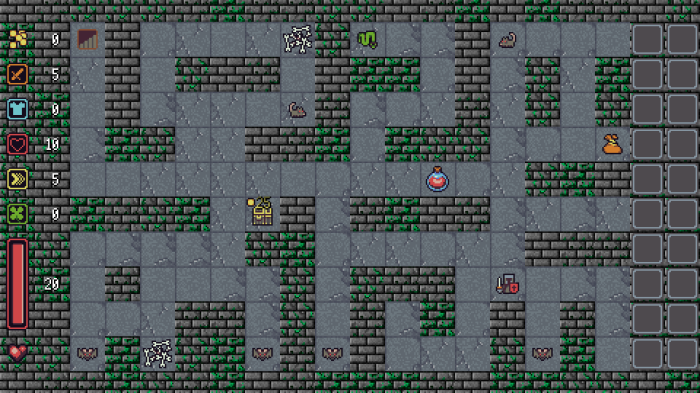
Reality check
After 3 months of development, when all of the core systems were in place and when I deemed big parts of the content non-placeholder, the time came to show the game to others. I realized something at that point, forcing me to make a huge decision about the project. The game was not fun ![]() . The idea was solid, the presentation was kind-of ok, but overall it was simply mediocre and a month of polishing and extra content in no way could change that!
. The idea was solid, the presentation was kind-of ok, but overall it was simply mediocre and a month of polishing and extra content in no way could change that!
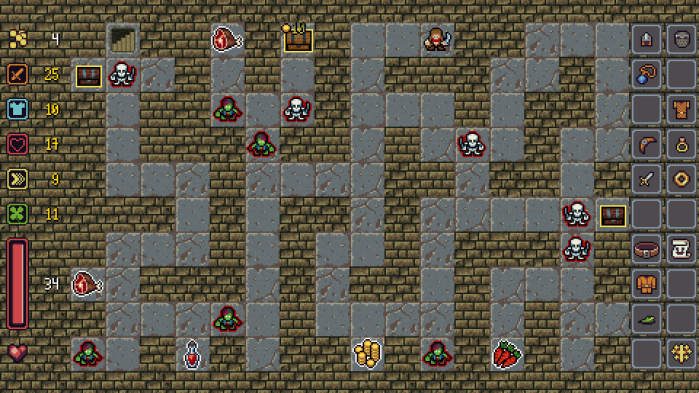
Back than I was super stressed out due to this and I thought about this as my hardest decision as a game maker, but looking back I think I made the right choice (now I feel like I actually only had this one). I decided to postpone release, explore the idea further even if it doubles!!! the originally planned development time (and it happened ![]() ) and most importantly I decided to not make or release a “shovelware”, because the world really isn’t interested in another one and I’m not interested in making/publishing one…
) and most importantly I decided to not make or release a “shovelware”, because the world really isn’t interested in another one and I’m not interested in making/publishing one…
Final scope
So after 4 months of development, feeling a bit glum, but also feeling reinvigorated to really make the most out of I Am Overburdened I extended the scope of the design & content and I also planned to polish the hell out of the game ![]() . This took another 4 months and almost a dozen private beta showings, but it resulted in a game I’m so proud of, that I always speak of it as a worthy addition to the roguelike genre and as a game that proudly stands on its own!
. This took another 4 months and almost a dozen private beta showings, but it resulted in a game I’m so proud of, that I always speak of it as a worthy addition to the roguelike genre and as a game that proudly stands on its own!

Some numbers about the end result:
It takes “only” around 30 to 40 minutes to complete the game on normal mode in one sitting, but due to its nature (somewhat puzzle-y, randomized dungeons & monster/loot placements + lots of items, unlocks and multiple game modes), the full content cannot be experienced with one play-through. I suspect it takes around 6 to 12 full runs (depending on skill and luck) to see most of what the game has to offer so it lends quite a few hours of fun ![]() . There are 10 different dungeon sets and they are built from multiple dozens of hand authored templates, so that no level looks even similar to the other ones in one session. They are populated by 18 different monsters each having their own skill and archetype (not just the same enemy re-skinned multiple times). And the pinnacle, the artifacts. The game has more than 120 unique items, all of them having a unique sprite and almost all of them having unique bonuses, skills (not just +attributes, but reactive and passive spells) and sound effects. This makes each try feel really different and item pickup/buy choices feel important and determinative. The game was also localized to Hungarian before release, because that is my native language so I could do a good job with the translation relatively fast and this also made sure, that the game is prepared to be easily localized to multiple languages if demand turns out to be high.
. There are 10 different dungeon sets and they are built from multiple dozens of hand authored templates, so that no level looks even similar to the other ones in one session. They are populated by 18 different monsters each having their own skill and archetype (not just the same enemy re-skinned multiple times). And the pinnacle, the artifacts. The game has more than 120 unique items, all of them having a unique sprite and almost all of them having unique bonuses, skills (not just +attributes, but reactive and passive spells) and sound effects. This makes each try feel really different and item pickup/buy choices feel important and determinative. The game was also localized to Hungarian before release, because that is my native language so I could do a good job with the translation relatively fast and this also made sure, that the game is prepared to be easily localized to multiple languages if demand turns out to be high.
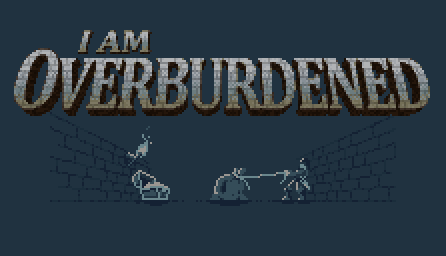
Production numbers
How much code I had to write and content I had to produce all in all to make this game? It is hard to describe the volume/magnitude with exact numbers, because the following charts may mean a totally different thing for a different game or in case of using different underlaying technologies, but a summary of all the asset files and the code lines can still give a vague idea of the work involved.

Writing and localization may not sound like a big deal, but the game had close to 5000 words to translate ![]() ! I know it may be less than the tenth of the dialogue of a big adventure or RPG game, but it is still way larger than the text in any of my projects before…
! I know it may be less than the tenth of the dialogue of a big adventure or RPG game, but it is still way larger than the text in any of my projects before…

I’ll go into the detailed time requirements of the full project too after I painted the whole picture, because no game is complete without appropriate marketing work, a super stressful release period ![]() and post-release support with updates and community management work
and post-release support with updates and community management work ![]() .
.
Marketing
If you try to do game development (or anything for that matter) as a business, you try to be smart about it, look up what needs to be done, how it has to be approached etc… I did my homework too and having published a game on Steam before I knew I had to invest a lot into marketing to succeed, otherwise simply no one will know about my game. As I said this is the “bad” part and I’ll be honest. I think I could have done a much better job, not just based on the results, but based on the hours and effort I put in, but let’s take it apart just like the development phase.
- Development blog/vlog
I started writing entries about the progress of the game really early on. I hoped to gather a small following who are interested in the game. I read that the effectiveness of these blogs are minimal, so I tried to maximize the results by syncing the posts to at least a dozen online communities. I also decided to produce a video version because it is preferred over text these days + I could show game-play footage too every now and then. I really enjoyed writing my thoughts down and liked making the videos so I will continue to do so for future projects, but they never really reached many people despite my efforts to share them here and there…
- Social media
I’ve tried to be active on Twitter during development, posting GIFs, screen-shots and progress reports multiple times a week. Later on I joined other big sites like Facebook and Reddit too to promote the game. In hindsight I should have been more active and should have joined Reddit way earlier. Reddit has a lot of rules and takes a lot more effort than Twitter or Facebook, but even with my small post count it drove 10 times more traffic to my store page, than any other social media site. Since the game features some comedy/satire and I produced a hell of a lot of GIFs, I tried less conventional routes too like 9gag, imgur, GIPHY and tumblr, but nothing really caught on.
- Wishlist campaign
I prepared a bunch of pictures up-front featuring some items and their humorous texts from the game. I posted one of these images every day starting from when the game could be wishlisted on Steam. I got a lot of love and a lot of hate too , but overall the effectiveness was questionable. It only achieved a few hundred wishlists up until the release day.
, but overall the effectiveness was questionable. It only achieved a few hundred wishlists up until the release day.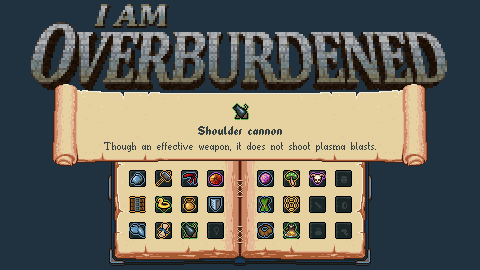
- Youtube & Twitch
For my previous Steam game I sent out keys on release day to a 100 or so Youtubers who played any kind-of co-op game before, resulting in nearly 0 coverage.
This time I gathered the contact info of a lot of Youtubers and Twitch streamers upfront. Many were hand collected + I got help from scripts, developer friends and big marketing lists ! I categorized them based on the games they play and tried talking to a few of those who played roguelikes way before release to peak their interest. Finally I tried to make a funny press release mail, hoping that they will continue reading after the first glance.
! I categorized them based on the games they play and tried talking to a few of those who played roguelikes way before release to peak their interest. Finally I tried to make a funny press release mail, hoping that they will continue reading after the first glance.
I sent out 300 keys the day before release and continued the following weeks, sending out 900 keys total.
And the results?! Mixed, could be worse, but it could be much better too. 130 keys were activated and around 40 channels covered the game, many already on release day and I’m really thankful for these people as their work helped me to reach more players.
Why is it mixed then? First, the videos did generate external traffic, but not a huge one. Second, I failed to capture the interest of big names. I also feel like I could have reached marginally better results by communicating lot a more and a lot earlier.
- Keymailer
I payed for some extra features and for a small promotion on this service for the release month. It did result in a tiny extra Youtube coverage, but based on both the results and the service itself all in all it wasn’t money well spent for me (even if it wasn’t a big cost).
- Press
This was a really successful marketing endeavor considering the efforts and the resulting coverage. I sent out 121 Steam keys with press release mails starting from the day before release. Both Rock Paper Shotgun and PC Gamer wrote a short review about it in their weekly unknown Steam gems series and the game got a lovely review from Indiegames.com. Also a lot of smaller sites covered it many praising it for being a well executed “chill” tongue-in-cheek roguelike . The traffic generated by these sites was moderate, but visible + I could read some comforting write-ups about the quality of the game.
. The traffic generated by these sites was moderate, but visible + I could read some comforting write-ups about the quality of the game.
- Ads
I tried Facebook ads during and a bit after the release week + in the middle of the winter sale. Since their efficiency can not be tracked too well I can only give a big guesstimate based on the analytics, sales reports and the comparison of the ad performances. I think they payed back their price in additional sales, but did not have much more extra effect. I believe they could work in a bigger scale too with more preparation and with testing out various formats, but I only payed a few bucks and tried two variants, so I wouldn’t say I have a good understanding of the topic yet.
Some lifetime traffic results:
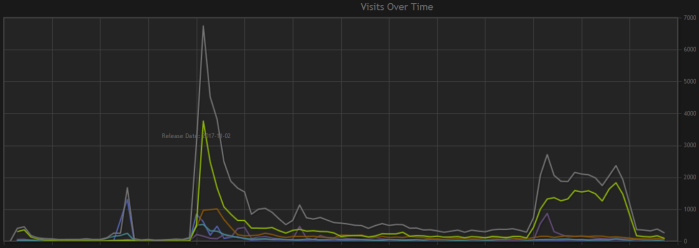
So much effort and so many people reached! Why is it “bad”, were the results such a mixed bag? Well, when it comes to development and design I’m really organized, but when it comes to marketing and pr I’m not at all. As I stated I never were really “active” on social media and I have a lot to learn about communication. Also the whole thing was not well prepared and the execution especially right at the release was a mess. The release itself was a mess ![]() . I think this greatly effected the efficiency! Just to be more specific I neglected and did not respond in time to a lot of mails and inquiries and the marketing tasks planned for the launch and for the week after took more than twice as much time to be completed as it should have. I think the things I did do were well thought out and creative, but my next releases and accompanying campaigns should be much more organized and better executed.
. I think this greatly effected the efficiency! Just to be more specific I neglected and did not respond in time to a lot of mails and inquiries and the marketing tasks planned for the launch and for the week after took more than twice as much time to be completed as it should have. I think the things I did do were well thought out and creative, but my next releases and accompanying campaigns should be much more organized and better executed.
Time & effort
I don’t think of myself as a super-fast super-productive human being. I know I’m a pretty confident and reliable programmer and also somewhat as a designer, but I’m a slowpoke when it comes art, audio and marketing/pr. For following my progress and for aiding estimations I always track my time down to the hour level. This also gives me confidence in my ability to deliver and allows me to post charts about the time it took to finish my projects ![]() .
.
Important thing to note before looking at the numbers: they are not 100% accurate and missing a portion of the work which were hard to track. To clarify, I collected the hours when I used my primary tools on my main PC (e.g.: Visual Studio, GIMP), but it was close to impossible to track all the tasks, like talking about the game on forums & social media, writing and replying-to my emails, browsing for solutions to specific problems and for collecting press contact information, you get the idea… All in all these charts still show a close enough summary.

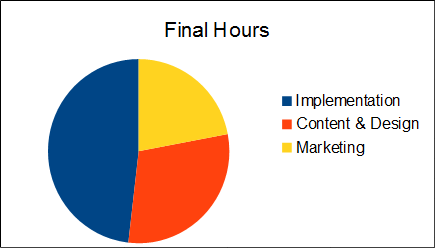



288 days passed between writing down the first line in the design doc and releasing the game on Steam. I “logged” in 190 full-time days. Of course more days were spent working on the game, but these were the ones when I spent a whole day working and could track significant portion of it + note that in the first 4 months of the project I spent only 4 days each week working on I Am Overburdened (a day weekly were spent on other projects).
Release
So how the release went? It was bad, not just bad, “ugly”. After I started my wishlist campaign, close to the originally planned date (2017. Oct. 23.) I had to postpone the release by a week due still having bugs in the build and not having time to fix them (went to a long ago planned and payed for vacation). I know this is amateurish, but the build was simply not “gold” two weeks prior to release ![]() . Even with the extra week I had to rush some fixes and of course there were technical issues on launch day. Fortunately I could fix every major problem in the first day after going live and there were no angry letters from the initial buyers, but having to fight fires (even though being a common thing in the software/game industry) was super tiring while I had to complete my marketing campaign and interact with the community at the same time. The game finally went live on Steam and itch.io on 2017. Nov. 2
. Even with the extra week I had to rush some fixes and of course there were technical issues on launch day. Fortunately I could fix every major problem in the first day after going live and there were no angry letters from the initial buyers, but having to fight fires (even though being a common thing in the software/game industry) was super tiring while I had to complete my marketing campaign and interact with the community at the same time. The game finally went live on Steam and itch.io on 2017. Nov. 2 ![]() ! I did not crunch at all during development, but I don’t remember sleeping too much during the week before and after launching the game. Big lesson for sure
! I did not crunch at all during development, but I don’t remember sleeping too much during the week before and after launching the game. Big lesson for sure ![]() .
.
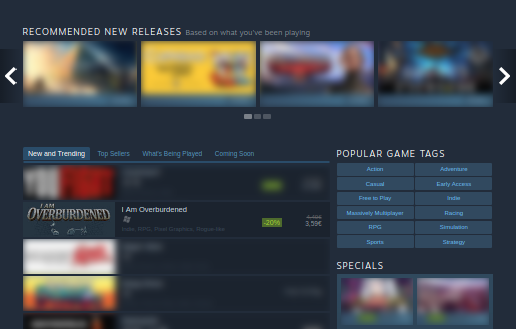
I saw some pictures about the game making it to the new and trending list on Steam, but it most probably spent only a few hours there. I never saw it even though I checked Steam almost every hour. I did saw it on the front-page though, next to the new and trending section in the under 5$ list ![]() . It spent a day or two there if I remember correctly. On the other hand, itch.io featured it on their front page and it’s been there for around a whole week
. It spent a day or two there if I remember correctly. On the other hand, itch.io featured it on their front page and it’s been there for around a whole week ![]() !
!
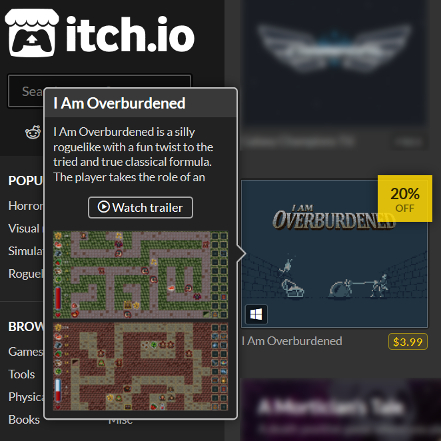
With all the coverage and good reviews did it at least sale well, did it make back it’s development costs, if not in the first weeks at least in the last two months?
Nope and it is not close to it yet…
Sales
In the last two months a bit more than 650 copies of I Am Overburdened were sold. Just to give an overview, 200 copies in the first week and reached 400 by the end of November, the remaining during the winter sale. This is not a devastating result, it is actually way better than my first Steam game, but I would be happier and optimistic about my future as game developer with reaching around 3 to 4 times the copies by now. To continue as a business for another year in a stable manner around 7 to 8 times the copies total (with price discounts in mind) during 2018 would have to be reached. I’m not sure if the game will ever reach those numbers though ![]() . If you do the math, that is still not “big money”, but it could still work for me because I live in eastern Europe (low living costs) + I’m not a big spender.
. If you do the math, that is still not “big money”, but it could still work for me because I live in eastern Europe (low living costs) + I’m not a big spender.

Of course this is an outcome to be prepared for and to be expected when someone starts a high-risk business, so I’m not at all “shocked” by the results. I knew this (or even a worse one) had a high chance. No matter how much effort one puts into avoiding failure, most of the game projects don’t reach monetary success. I’m just feeling a bit down, because I enjoyed every minute of making this game, a.k.a. “dream job” ![]() , maybe except for the release
, maybe except for the release ![]()
![]() , but most probably I won’t be able to continue my journey to make another “bigger” commercial game. I may try to build tiny ones, but certainly will not jump into a 6+ months long project again.
, but most probably I won’t be able to continue my journey to make another “bigger” commercial game. I may try to build tiny ones, but certainly will not jump into a 6+ months long project again.
Closing words
It is a bit early to fully dismiss I Am Overburdened and my results. It turned out to be an awesome game. I love it and I’m super proud of it. I’m still looking for possibilities to make money with it (e.g.: ports) + over a longer time period with taking part in several discount events the income generated by it may cover at least a bigger portion of my investment. No one buys games for full price on PC these days, even AAA games are discounted by 50% a few months after release ![]() , so who knows…
, so who knows…
If you have taken a liking to play the game based on the pictures/story you can buy it (or wishlist it ![]() ) at Steam or at itch.io for 4.99$ (may vary based on region).
) at Steam or at itch.io for 4.99$ (may vary based on region).
As an extra for getting all the way here in the post, I recorded a “Gource” video of the I Am Overburdened repository right before Christmas. I usually check all the files into version control, even marketing materials, so you can watch all the output of almost a year of work condensed into 3 minutes. Enjoy ![]() !
!
Thank you very much for following my journey and thanks for reading.
Take care!


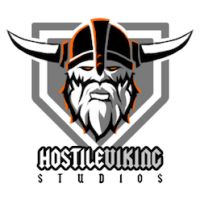


Really wish this had done better!